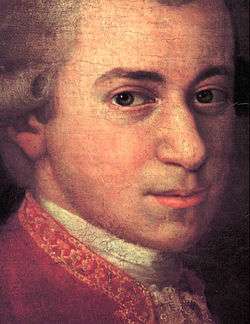Mass in C major, K. 337 "Solemnis"
The Missa solemnis in C major by Wolfgang Amadeus Mozart, K. 337, was written in 1780 for Salzburg.[1] It was Mozart's last complete mass.[2] The mass is scored for soloists, choir, 2 oboes,[3] 2 bassoons, 2 trumpets, 3 trombones,[4] strings (without violas[5]) and organ, the latter supplying figured bass for most of the duration.
The Sanctus recalls features of the Kyrie, and also has a violin figure Mozart used again in Idomeneo.[6] The Benedictus is peculiar for Mozart's mass settings in that it is an austere fugue in an archaic style.[7]
Fragmentary first Credo setting and its completion
The autograph of the mass features an alternative setting of the Credo. This setting has a length of 136 measures and abruptly ends after the words "cuius regni non erit finis".[8] It is not clear why Mozart stopped work on this setting and instead began work on the second – and complete – setting of the Credo on the next page of the autograph, but this may be due to the fact that Mozart had forgotten to set the words "sub Pontio Pilato" to music in the first draft. In the years 1989 and 2003 Dr Murl Sickbert completed the fragment; in 2006 it was performed at Hardin–Simmons University, Texas.[9]
Notes
- ↑ R. W. Gutman, Mozart: A Cultural Biography p. 479
- ↑ P. Melograni et al, Wolfgang Amadeus Mozart: A Biography p. 116
- ↑ p. 130 (2002) Green
- ↑ R. W. Gutman, Mozart: A Cultural Biography p. 480
- ↑ p. 130 (2002) Green
- ↑ D. Heartz, Haydn, Mozart, and the Viennese School: 1740 — 1780 W. W. Norton & Co. p. 668
- ↑ D. Heartz, p. 668
- ↑ cf. Introduction to the NMA score of the mass, pp. XV-XVI, http://dme.mozarteum.at/DME/nma/nma_cont.php?vsep=7&gen=edition&l=2&p1=-21
- ↑ "First Recording of Murl Sickbert's Completion of Credo to K337". MozartForum.com. 23 February 2007. Archived from the original on 8 August 2007. Retrieved October 2014. Check date values in:
|access-date=(help)
References
- Green (2002) Jonathan D. New York A Conductor's Guide to Choral-Orchestral Works, Classical Period: Volume 1: Haydn and Mozart Scarecrow Press
- Heartz (1995) Daniel. New York. Haydn, Mozart, and the Viennese School: 1740 — 1780 W. W. Norton & Co.
- Hugues (1974) Rosemary. London. Haydn. J. M. Dent & Sons Ltd
- Schenbeck (1996) Lawrence. Chapel Hill, North Carolina Joseph Haydn and the Classical Choral Tradition Hinshaw Music
External links
- Mass in C major, K. 337 "Solemnis": Score and critical report (German) in the Neue Mozart-Ausgabe
- Free scores of Missa Solemnis in C (KV 337) in the Choral Public Domain Library (ChoralWiki)
- Missa solemnis in C major, K.337: Scores at the International Music Score Library Project
